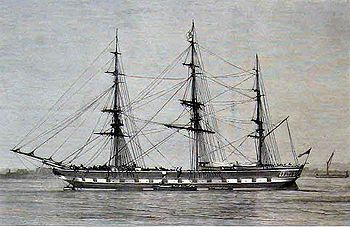Cospatrick (ship)
Cospatrick | |
| Career (Great Britain) | |
|---|---|
| Name: | Cospatrick |
| Acquired: | 1862 by Smith, Fleming & Co. |
| Commissioned: | 1856 |
| Fate: | Destroyed by fire south of Cape of Good Hope in 1874 |
| General characteristics | |
| Class and type: | Blackwall Frigate |
| Tonnage: | 1199 gross registered tons |
| Length: | 191 feet (58 m) |
| Beam: | 34 feet (10 m) |
| Depth of hold: | 23.5 feet (7.2 m) |
| Propulsion: | Sail |
| Sail plan: | full-rigged ship |
| Complement: | 44 |
The Cospatrick was a wooden 3-masted full-rigged sailing ship that was the victim of one of the worst shipping disasters to a merchant ship during the 19th century. The ship caught fire south of the Cape of Good Hope on 17 November 1874 while on a voyage from Gravesend, England to Auckland, New Zealand. Only 3 of 472 persons on board at the time ultimately survived, making it New Zealand's worst ever civil disaster.[1]
Contents
History of the Cospatrick
The Cospatrick was a Blackwall Frigate of 1199 tons, on dimensions of 191 feet (58 m) length between perpendiculars, 34 feet (10 m) beam, 23.5 feet (7.2 m) depth of hold, built at Moulmein (now Mawlamyaing) in Burma in 1856 for prominent London shipowner Duncan Dunbar. Following his death in 1862 the ship was sold to Smith, Fleming & Co. of London. The Cospatrick spent most of her career trading between England and India carrying passengers, troops and cargo. In 1863 she was engaged with other ships to lay a telegraphic cable in the Persian Gulf. She had also made two voyages to Australia before being sold to Shaw, Savill & Co. of London in 1873. The Cospatrick then became one of many ships owned by this company that carried cargo and emigrants from England to New Zealand.
Destruction of the Cospatrick
The Cospatrick sailed from Gravesend for Auckland on 11 September 1874 with 433 passengers and 44 crew under Captain Alexander Elmslie.[2] The passengers included 429 assisted emigrants, of which 125 were women and 126 were children. During the course of the voyage, eight infants died and one was born (plus another still-birth).[3]
The voyage was otherwise uneventful until about 12.45 a.m. on 17 November - about twelve hours after the vessel's position was determined as 400 miles (640 km) south-west of the Cape of Good Hope.[4] The ship's second mate, Henry Macdonald, was alerted by a strong smell of smoke at the end of his watch. When he went back on deck to raise the alarm, he found that fire had broken out in the boatswain's store, where oakum, tar, paint and ropes were stored. The crew was summoned to man the fire hoses, while the Captain and crew tried, but failed, to turn the ship before the wind, to take the smoke and flames forward and to contain the fire.
The fire rapidly grew out of control and panic ensued. Although there were five lifeboats on board capable of carrying 187 people, only one was successfully launched although a second was found capsized and was righted. Initially 61 passengers and crew survived, but one of the boats went missing during a storm on the night of 21 November. Those in the remaining boat were infamously reduced to cannibalism[5], before five survivors were rescued by the ship British Sceptre on 27 November 1874. They had drifted about 500 miles (800 km) north-east from where the Cospatrick had sunk. Two of the survivors died shortly after being rescued.
The aftermath
An inquiry found it most likely that the cause of the fire had been members of the crew or passengers broaching cargo in the hold using a naked light, thus igniting the large quantity of inflammable cargo including tar, oil, varnish and pitch. Another theory was spontaneous combustion. The lack of lifeboats and inability to launch them successfully at sea also caused much public outrage, but little was done until after the loss of the Titanic in 1912.
See also
References
- ↑ "Fire on the Cospatrick". Te Ara Encyclopedia of New Zealand. http://www.teara.govt.nz/en/the-voyage-out/2/6. Retrieved 2010-02-07.
- ↑ Basil Lubbock (1921). The Colonial Clippers. Kessinger Publishing. ISBN 1417964162. http://books.google.com/books?id=9GV5or-W9OUC.
- ↑ Charles R. Clark (2006). Women and Children Last - The Burning of the Emigrant Ship Cospatrick. Dunedin, New Zealand: Otago University Press. ISBN 1877372145.
- ↑ "Burning of the Emigrant-Ship Cospatrick at Sea". Illustrated London News. January 2, 1875. http://www.theshipslist.com/accounts/cospatrick.html.
- ↑ Alfred William Brian Simpson (1994). Cannibalism and the Common Law. Continuum International Publishing Group. ISBN 1852852003. http://books.google.com.au/books?id=vIZ7bFBjV0YC.

